

The nomination of Droupadi Murmu as the NDA candidate for the next President of India by the BJP has caught the political circles by surprise. Her nomination has put the opposition on a backfoot and in an awkward situation. It is so for a simple reason that she belongs to the category of the scheduled tribe and it is the first time in independent India that a person from the scheduled tribe is being considered for the highest constitutional post.
It is therefore greatly symbolic and, more than that, of great electoral value. The tribes constitute 8.6 percent of the total population and they make significant differences in electoral politics in many states. The Santhals, to which Murmu belongs, are the third largest tribal group in India after the Bhils and Gonds and form a significant population in Jharkhand, West Bengal, Odisha, and Assam.
The tribal communities had been the most marginalised section of the Indian society at the dawn of independence, they continue to be so even after more than seven decades of affirmative action programmes in the form of preferential policies such as reservation in state employment and higher educational institution and special concern of them for economic and social development, especially education and health.
The former is contingent on the latter, but the latter itself represents a sorry state of affairs. Tribes represent a disproportionate share of people living below the poverty line and with poor educational and health status. This has been due partly to the ineffective implementation of such policies. However, the more important reason has been the negligence and even violation of the special constitutional and legal provisions aimed at protecting their land, forest, and other resources with which their livelihood has been intricately intertwined. The control of rights and access to land and forest customarily held by tribal communities had been steadily taken control over them by the state through a wide range of enactment of new laws and policies as well as the widespread use of old laws and policies detrimental to protective provisions in the constitution and laws. All these were geared towards the acquisition of their land and forest for various so-called development, infrastructure and conservation projects of national and state importance of which tribes rather than being the partakers, have become the victims.
Read | Tribal ‘First Citizen’: A dystopia dressed in policy bling
The new economic reform ushered in 1991 that paved the way for the entry of the private sector in tribal areas only aggravated the existing depressing situation resulting in tension and conflict between the state and the people.
As a safety valve, protective and empowering laws were enacted in favour of tribal people. The prominent among them have been the PESA 1996, FRA 2006, and the Right to Fair Compensation and Transparency in Land Acquisition, Rehabilitation and Resettlement Act, (LARR) 2013.
These acts broadly aim to address the historical damage and injustice done to the tribal people and restore the rights they enjoyed traditionally and historically.
The record of the present regime in ensuring the implementation of these acts in letter and spirit has been on the whole negative. As for the PESA, the regime is almost indifferent since this is now a state subject. The provisions of the FRA are constantly being tampered with. And so has been the case with the LARR. Further, those working in support of the constitutional and legally conferred rights are labelled as the anti-nationals and Naxals.
On this backdrop, nominating a person from the tribal community to the highest constitutional position seems nothing more than a paternalist symbolic gesture. It is not aimed at protecting and empowering tribal people as the constitution envisages.
(The writer is a former Professor of Sociology at Delhi School of Economics)